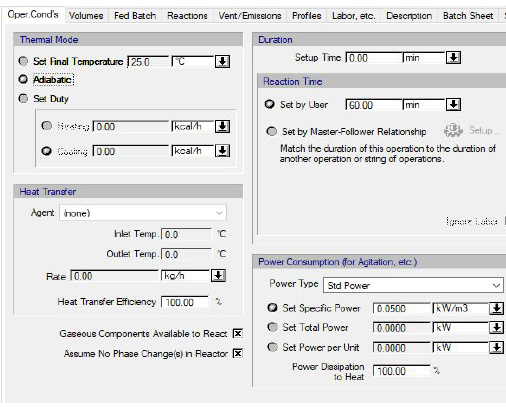

The following table shows a brief description of the variables appearing in this tab. The table also displays their default values and their generally acceptable range:
|
Variable |
Default Value |
Range |
|
|
||
|
◙ Final Temperature (oC) |
25.0 |
Positive |
|
◙ Heating Duty (kcal/h) |
0.0 |
Positive |
|
◙ Cooling Duty (kcal/h) |
0.0 |
Positive |
|
○ Heat Transfer Agent Name |
<Chilled Water> |
Any Heat Transfer Agent |
|
● Inlet Temp. (oC) |
5.0 |
Positive |
|
● Outlet Temp. (oC) |
10.0 |
Positive |
|
● Rate (kg/h) |
0.0 |
Positive |
|
○ Heat Transfer Efficiency(%) |
100.0 |
[0,100) |
|
○ Setup Time (min) |
0.0 |
Positive |
|
○ Reaction Time (min) |
60.0 |
Positive |
|
○ Ignore Labor? |
Yes |
Yes/No |
|
○ Power Type |
<Std Power> |
Any Power Type |
|
◙ Specific Power (Per Volume) (kW/m3) |
0.1 |
Positive |
|
◙ Total Power (kW) |
0.0 |
Positive |
|
◙ Power Per Unit (kW) |
0.0 |
Positive |
|
○ Power Dissipation to Heat (%) |
100.0 |
[0,100] |
|
○ Gaseous Components Available to React |
Yes |
Yes/No |
Symbol Key: ○ User-specified value (always input); ● Calculated value (always output); ◙ Sometimes input, sometimes output
The following list describes the available specification choices in this tab; for more details on how these are implemented, see Stoichiometric Reaction Operations: Modeling Calculations.
•Process Time Options...
a) You can set the process time (Reaction Time).
b) You can match the duration of this operation to the duration of another operation by introducing a master-slave relationship between the two operations. The program will match the setup-time, the process time and the turnaround time of this operation (the ‘slave’) with the corresponding times of the reference operation (the ‘master’ operation). For more on master-slave relationship, see The Scheduling Tab.
•Gaseous Components...
If you don’t check the ‘Gaseous Components Available to React’ option, then only the liquid components will be considered for the reaction.